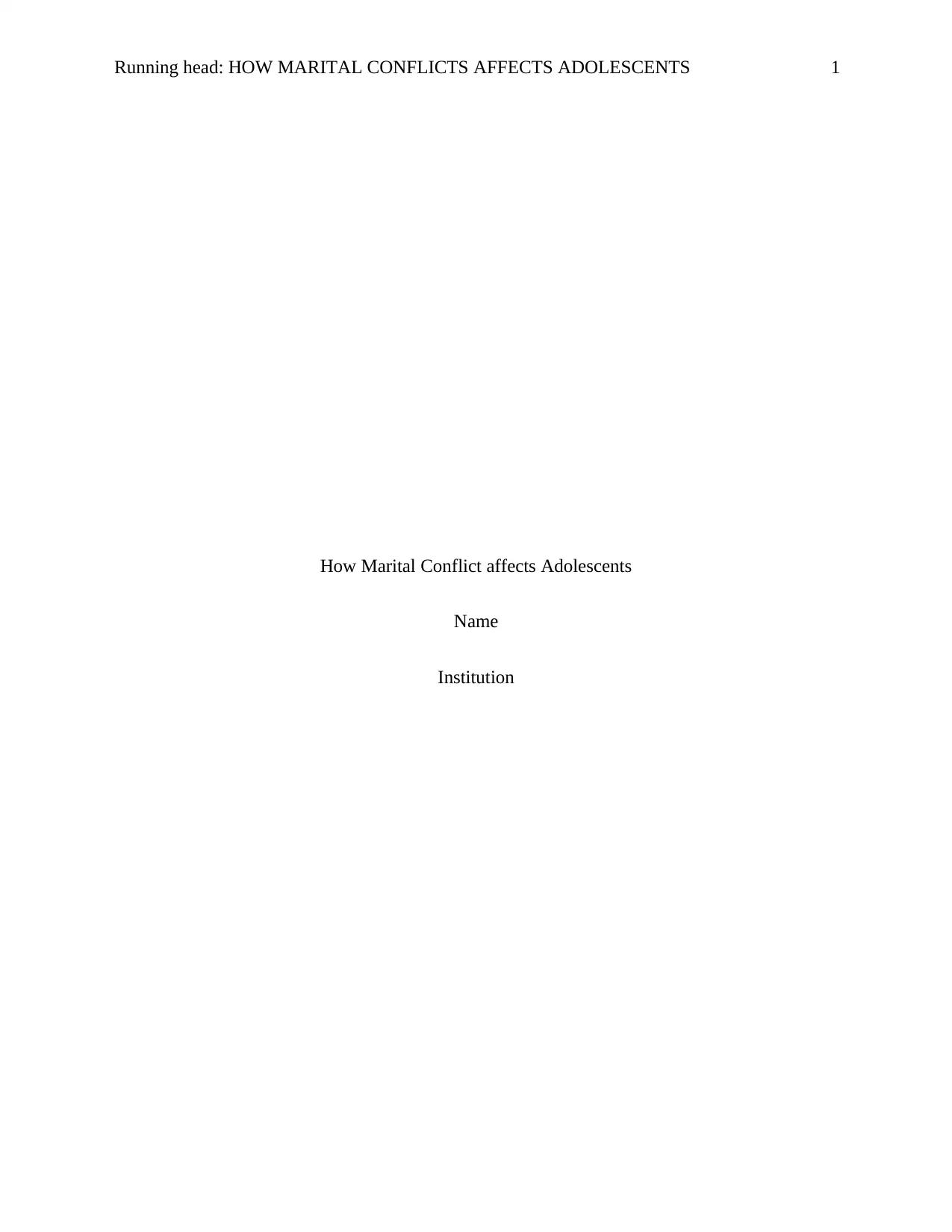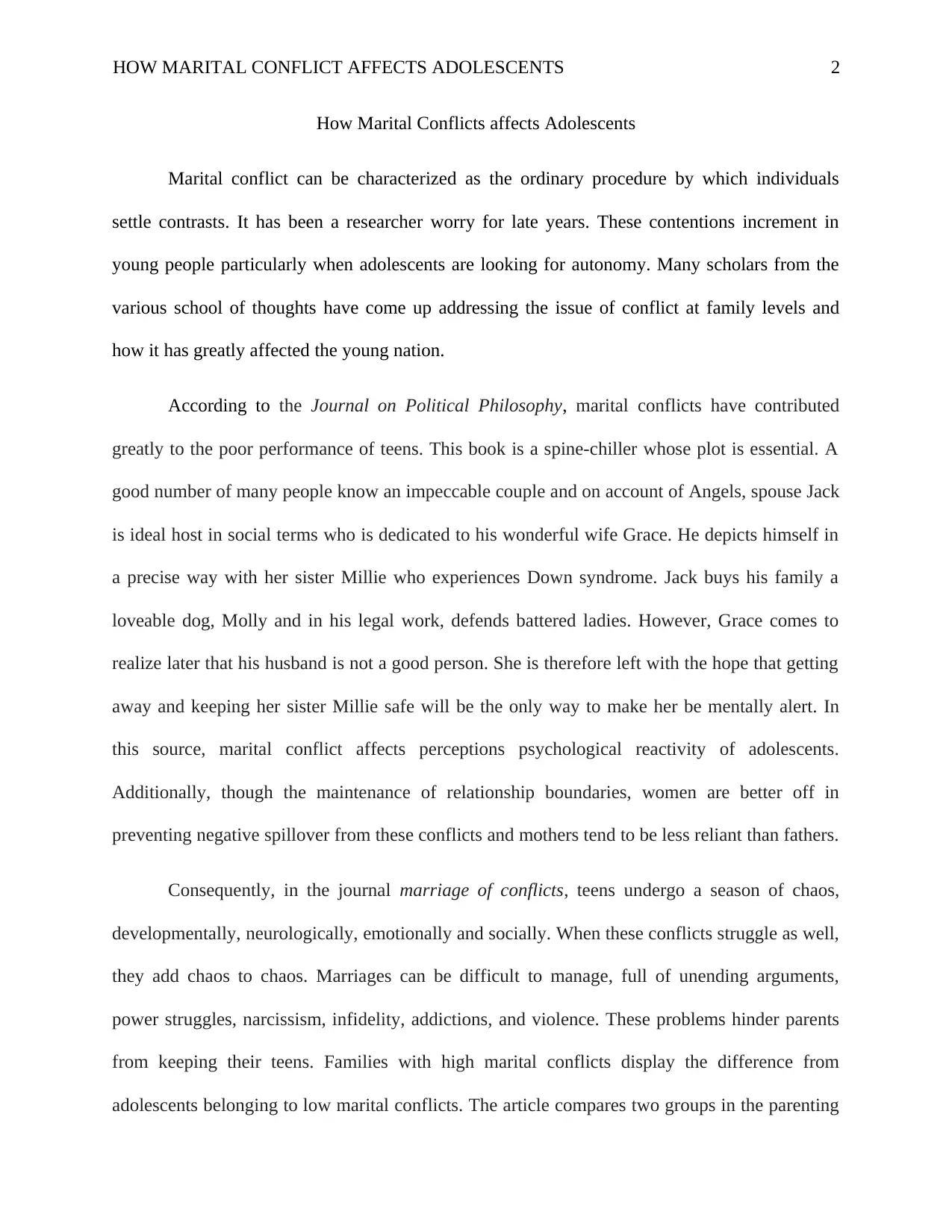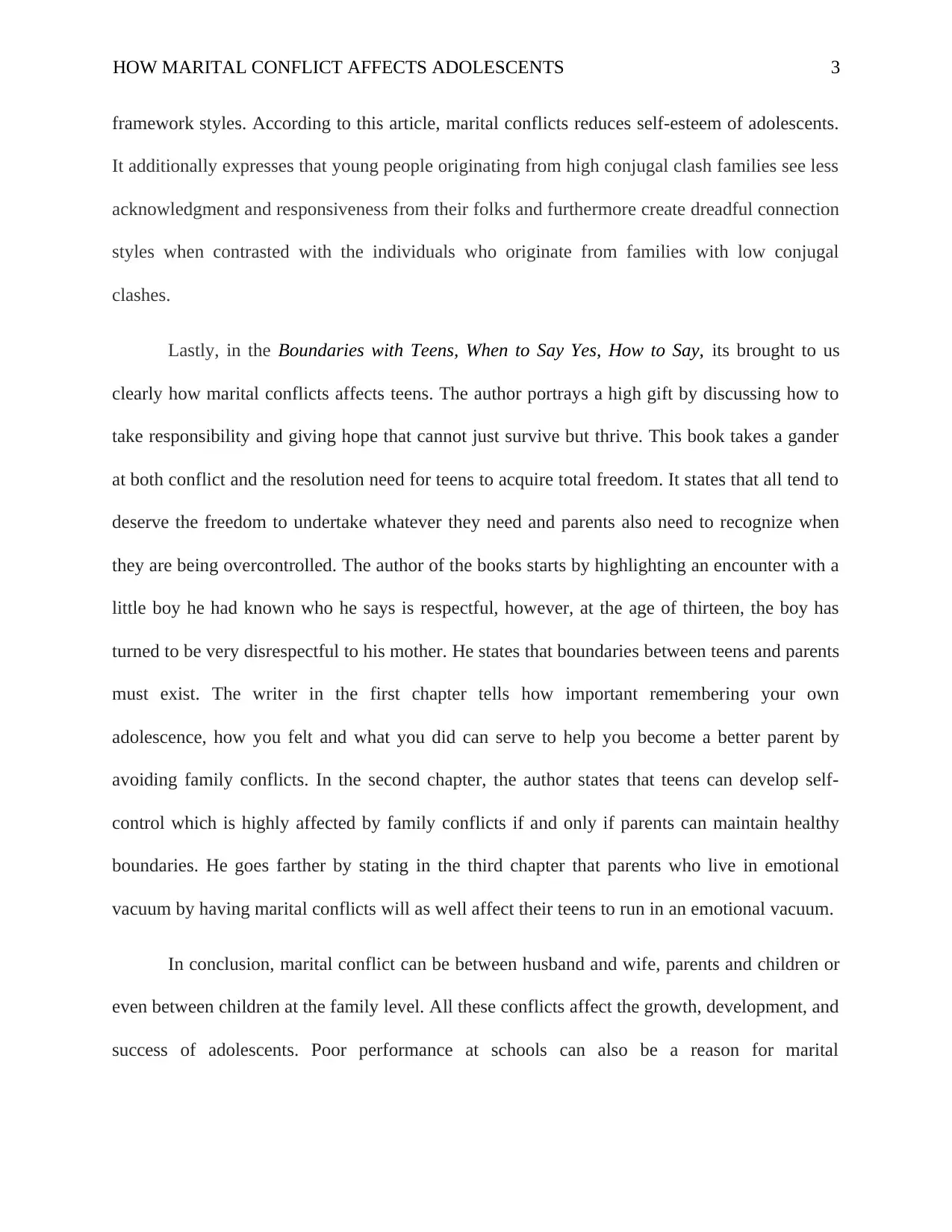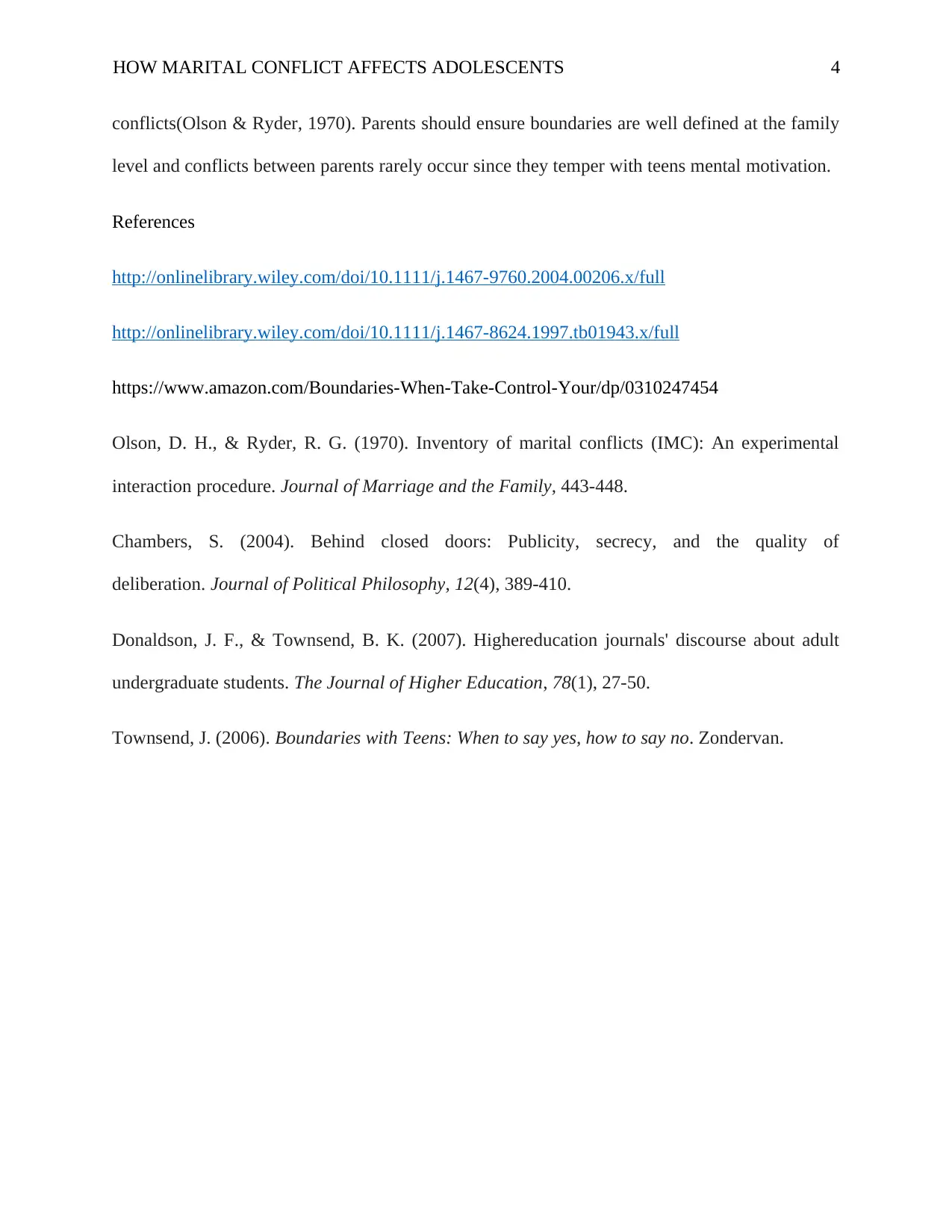How Marital Conflict affects Adolescents
VerifiedAdded on 2023/06/11
|4
|911
|272
AI Summary
Marital conflict affects adolescents' growth, development, and success. This article discusses the impact of marital conflicts on adolescents' psychological, neurological, emotional, and social development. It also highlights the importance of maintaining healthy boundaries at the family level to prevent negative spillover from conflicts.
Contribute Materials
Your contribution can guide someone’s learning journey. Share your
documents today.

Running head: HOW MARITAL CONFLICTS AFFECTS ADOLESCENTS 1
How Marital Conflict affects Adolescents
Name
Institution
How Marital Conflict affects Adolescents
Name
Institution
Secure Best Marks with AI Grader
Need help grading? Try our AI Grader for instant feedback on your assignments.

HOW MARITAL CONFLICT AFFECTS ADOLESCENTS 2
How Marital Conflicts affects Adolescents
Marital conflict can be characterized as the ordinary procedure by which individuals
settle contrasts. It has been a researcher worry for late years. These contentions increment in
young people particularly when adolescents are looking for autonomy. Many scholars from the
various school of thoughts have come up addressing the issue of conflict at family levels and
how it has greatly affected the young nation.
According to the Journal on Political Philosophy, marital conflicts have contributed
greatly to the poor performance of teens. This book is a spine-chiller whose plot is essential. A
good number of many people know an impeccable couple and on account of Angels, spouse Jack
is ideal host in social terms who is dedicated to his wonderful wife Grace. He depicts himself in
a precise way with her sister Millie who experiences Down syndrome. Jack buys his family a
loveable dog, Molly and in his legal work, defends battered ladies. However, Grace comes to
realize later that his husband is not a good person. She is therefore left with the hope that getting
away and keeping her sister Millie safe will be the only way to make her be mentally alert. In
this source, marital conflict affects perceptions psychological reactivity of adolescents.
Additionally, though the maintenance of relationship boundaries, women are better off in
preventing negative spillover from these conflicts and mothers tend to be less reliant than fathers.
Consequently, in the journal marriage of conflicts, teens undergo a season of chaos,
developmentally, neurologically, emotionally and socially. When these conflicts struggle as well,
they add chaos to chaos. Marriages can be difficult to manage, full of unending arguments,
power struggles, narcissism, infidelity, addictions, and violence. These problems hinder parents
from keeping their teens. Families with high marital conflicts display the difference from
adolescents belonging to low marital conflicts. The article compares two groups in the parenting
How Marital Conflicts affects Adolescents
Marital conflict can be characterized as the ordinary procedure by which individuals
settle contrasts. It has been a researcher worry for late years. These contentions increment in
young people particularly when adolescents are looking for autonomy. Many scholars from the
various school of thoughts have come up addressing the issue of conflict at family levels and
how it has greatly affected the young nation.
According to the Journal on Political Philosophy, marital conflicts have contributed
greatly to the poor performance of teens. This book is a spine-chiller whose plot is essential. A
good number of many people know an impeccable couple and on account of Angels, spouse Jack
is ideal host in social terms who is dedicated to his wonderful wife Grace. He depicts himself in
a precise way with her sister Millie who experiences Down syndrome. Jack buys his family a
loveable dog, Molly and in his legal work, defends battered ladies. However, Grace comes to
realize later that his husband is not a good person. She is therefore left with the hope that getting
away and keeping her sister Millie safe will be the only way to make her be mentally alert. In
this source, marital conflict affects perceptions psychological reactivity of adolescents.
Additionally, though the maintenance of relationship boundaries, women are better off in
preventing negative spillover from these conflicts and mothers tend to be less reliant than fathers.
Consequently, in the journal marriage of conflicts, teens undergo a season of chaos,
developmentally, neurologically, emotionally and socially. When these conflicts struggle as well,
they add chaos to chaos. Marriages can be difficult to manage, full of unending arguments,
power struggles, narcissism, infidelity, addictions, and violence. These problems hinder parents
from keeping their teens. Families with high marital conflicts display the difference from
adolescents belonging to low marital conflicts. The article compares two groups in the parenting

HOW MARITAL CONFLICT AFFECTS ADOLESCENTS 3
framework styles. According to this article, marital conflicts reduces self-esteem of adolescents.
It additionally expresses that young people originating from high conjugal clash families see less
acknowledgment and responsiveness from their folks and furthermore create dreadful connection
styles when contrasted with the individuals who originate from families with low conjugal
clashes.
Lastly, in the Boundaries with Teens, When to Say Yes, How to Say, its brought to us
clearly how marital conflicts affects teens. The author portrays a high gift by discussing how to
take responsibility and giving hope that cannot just survive but thrive. This book takes a gander
at both conflict and the resolution need for teens to acquire total freedom. It states that all tend to
deserve the freedom to undertake whatever they need and parents also need to recognize when
they are being overcontrolled. The author of the books starts by highlighting an encounter with a
little boy he had known who he says is respectful, however, at the age of thirteen, the boy has
turned to be very disrespectful to his mother. He states that boundaries between teens and parents
must exist. The writer in the first chapter tells how important remembering your own
adolescence, how you felt and what you did can serve to help you become a better parent by
avoiding family conflicts. In the second chapter, the author states that teens can develop self-
control which is highly affected by family conflicts if and only if parents can maintain healthy
boundaries. He goes farther by stating in the third chapter that parents who live in emotional
vacuum by having marital conflicts will as well affect their teens to run in an emotional vacuum.
In conclusion, marital conflict can be between husband and wife, parents and children or
even between children at the family level. All these conflicts affect the growth, development, and
success of adolescents. Poor performance at schools can also be a reason for marital
framework styles. According to this article, marital conflicts reduces self-esteem of adolescents.
It additionally expresses that young people originating from high conjugal clash families see less
acknowledgment and responsiveness from their folks and furthermore create dreadful connection
styles when contrasted with the individuals who originate from families with low conjugal
clashes.
Lastly, in the Boundaries with Teens, When to Say Yes, How to Say, its brought to us
clearly how marital conflicts affects teens. The author portrays a high gift by discussing how to
take responsibility and giving hope that cannot just survive but thrive. This book takes a gander
at both conflict and the resolution need for teens to acquire total freedom. It states that all tend to
deserve the freedom to undertake whatever they need and parents also need to recognize when
they are being overcontrolled. The author of the books starts by highlighting an encounter with a
little boy he had known who he says is respectful, however, at the age of thirteen, the boy has
turned to be very disrespectful to his mother. He states that boundaries between teens and parents
must exist. The writer in the first chapter tells how important remembering your own
adolescence, how you felt and what you did can serve to help you become a better parent by
avoiding family conflicts. In the second chapter, the author states that teens can develop self-
control which is highly affected by family conflicts if and only if parents can maintain healthy
boundaries. He goes farther by stating in the third chapter that parents who live in emotional
vacuum by having marital conflicts will as well affect their teens to run in an emotional vacuum.
In conclusion, marital conflict can be between husband and wife, parents and children or
even between children at the family level. All these conflicts affect the growth, development, and
success of adolescents. Poor performance at schools can also be a reason for marital

HOW MARITAL CONFLICT AFFECTS ADOLESCENTS 4
conflicts(Olson & Ryder, 1970). Parents should ensure boundaries are well defined at the family
level and conflicts between parents rarely occur since they temper with teens mental motivation.
References
http://onlinelibrary.wiley.com/doi/10.1111/j.1467-9760.2004.00206.x/full
http://onlinelibrary.wiley.com/doi/10.1111/j.1467-8624.1997.tb01943.x/full
https://www.amazon.com/Boundaries-When-Take-Control-Your/dp/0310247454
Olson, D. H., & Ryder, R. G. (1970). Inventory of marital conflicts (IMC): An experimental
interaction procedure. Journal of Marriage and the Family, 443-448.
Chambers, S. (2004). Behind closed doors: Publicity, secrecy, and the quality of
deliberation. Journal of Political Philosophy, 12(4), 389-410.
Donaldson, J. F., & Townsend, B. K. (2007). Highereducation journals' discourse about adult
undergraduate students. The Journal of Higher Education, 78(1), 27-50.
Townsend, J. (2006). Boundaries with Teens: When to say yes, how to say no. Zondervan.
conflicts(Olson & Ryder, 1970). Parents should ensure boundaries are well defined at the family
level and conflicts between parents rarely occur since they temper with teens mental motivation.
References
http://onlinelibrary.wiley.com/doi/10.1111/j.1467-9760.2004.00206.x/full
http://onlinelibrary.wiley.com/doi/10.1111/j.1467-8624.1997.tb01943.x/full
https://www.amazon.com/Boundaries-When-Take-Control-Your/dp/0310247454
Olson, D. H., & Ryder, R. G. (1970). Inventory of marital conflicts (IMC): An experimental
interaction procedure. Journal of Marriage and the Family, 443-448.
Chambers, S. (2004). Behind closed doors: Publicity, secrecy, and the quality of
deliberation. Journal of Political Philosophy, 12(4), 389-410.
Donaldson, J. F., & Townsend, B. K. (2007). Highereducation journals' discourse about adult
undergraduate students. The Journal of Higher Education, 78(1), 27-50.
Townsend, J. (2006). Boundaries with Teens: When to say yes, how to say no. Zondervan.
1 out of 4
Your All-in-One AI-Powered Toolkit for Academic Success.
+13062052269
info@desklib.com
Available 24*7 on WhatsApp / Email
![[object Object]](/_next/static/media/star-bottom.7253800d.svg)
Unlock your academic potential
© 2024 | Zucol Services PVT LTD | All rights reserved.
